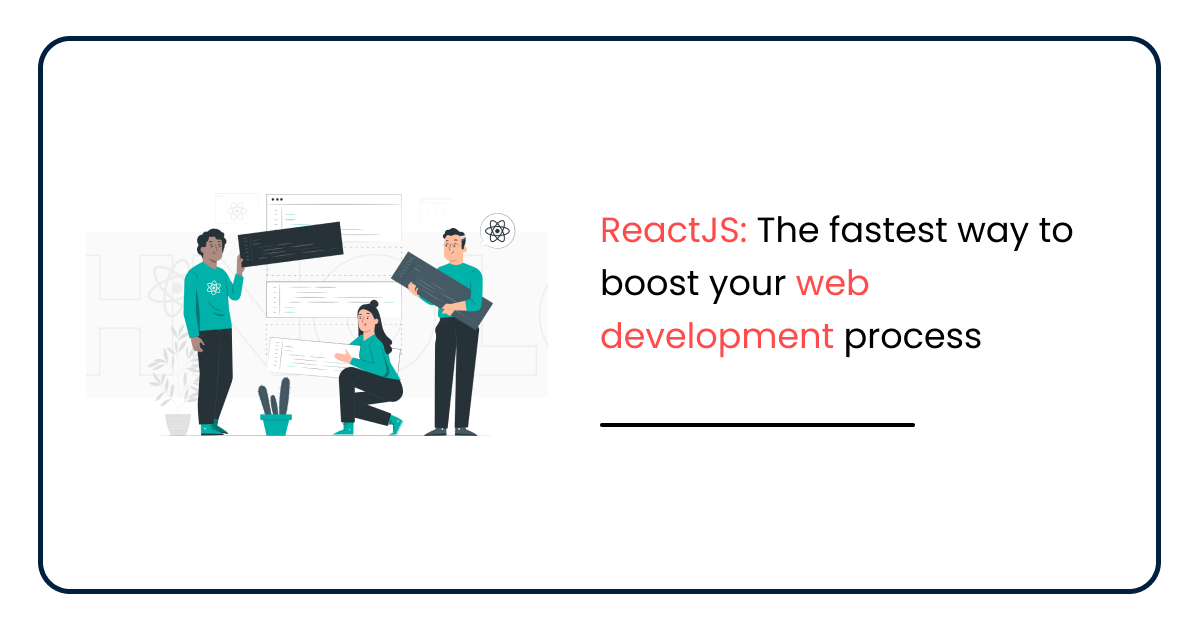
ReactJS: The fastest way to boost your web development process
ReactJS framework was released on Facebook in 2013 by Jordan Walke. ReactJS is an open-source library designed to help engineers build. Their web applications faster and easier using the components of a virtual DOM library called React. So, ReactJS has the capability to make web apps faster because it renders. Web pages more efficiently than most other frameworks, e.g., AngularJS, Backbone, etc.
What is React?
At its core, React is a library for building user interfaces and unidirectional data. Flow that makes it easier to update components with new information. If you’ve ever used an interface created with HTML and CSS, you’ll find this concept pretty familiar.
However, React takes it one step further by defining how data should flow in a component. Tree instead of relying on manually maintaining that hierarchy with parents. Child DOM nodes (DOM stands for Document Object Model). And when state changes in the application occur. React updates only those pieces of the UI which need updating instead of running through the entire component tree again.
What are the benefits of using react?
– React speeds up your application by only updating the part of the DOM that has changed.
– React provides you with a great balance between performance and expressiveness.
– Simply put, it makes creating large interactive apps easier and less messy.
– React uses one-way data binding and can reduce some of the redundant code within loops. It is also perfect for those who are new to coding because its syntax is easy to learn.
In addition, using react allows developers to focus on what they really want their app to do rather than how they want it to look or work because they don’t have as many styling or HTML formatting concerns. You’ll spend more time building things and less time fixing them. It’s also a great tool for those looking for something simple yet powerful and doesn’t involve a lot of complex libraries or architectures from other frameworks like Angular or Vuejs.
Why you should use React for Mobile App Development?
The JSX syntax is a helpful addition that has helped many developers when switching to React. Its fundamental aim is to make it easier for developers by making the code concise, readable and elegant. It gives developers an opportunity to use HTML-like code when writing their React components.
Basically, it makes building large applications much more manageable because you don’t have as many HTML tags you need to remember or wrestle with as was the case before using JSX. You can also leverage JavaScript’s prototype system which makes coding in React very intuitive. But rather sets up some of the groundwork and scaffolding.
Read More: 10 Top Web Development Frameworks to Check Out in 2022-23
As someone who had been working in jQuery for years, I find myself thinking about programming in terms of DOM nodes instead of just raw objects as I did in my previous experience with AngularJS. However, JSX made it very easy to adjust my mindset so that I could get back up to speed quickly without feeling overwhelmed by all the new concepts being thrown at me on every page load.
What’s different in JSX from HTML?
JSX is an XML-like syntax extension to ECMAScript. JSX provides some syntactic sugar, reducing the need for tag names and allowing property bindings like {{this. name}}. But it’s not just syntactic sugar, because JSX transpiler down into a normal JavaScript class that has a render() method with HTML functionality built in.
This means that you get all the advantages of a compiled language (code isolation, static type checking) with the programming convenience of ECMAScript. And you can use JSX within any JavaScript environment which supports ECMAScript 3 or higher, so no browser plugins are needed!
What are other differences between Html and JSX?
It has been well documented that React JS is a faster and more efficient alternative to traditional page-based UI rendering engines. There are also some other key benefits which make React JS more advantageous over Html and JSX in certain scenarios. One of the major pros of using React is that it speeds up the search indexing process, which ultimately improves website loading times.
Additionally, developers can take advantage of a whole host of high-quality open source libraries designed to do just about anything with React out-of-the-box. This means that there are no tricky npm or yarn installations required, which saves developers lots of time when compared with more complicated frameworks like Angular
How do you set up a dev environment with node js and MongoDB?
Once you have node js and MongoDB installed, all you need is a code editor for React, we recommend Atom. Once you have Atom open and set up, install one of the latest versions of React and React-DOM by typing npm install react in your terminal or console. React js development company.
Once it finishes downloading and installing, head over to the editor tab and type npm start. This will boot up a node server that will serve index.html and host our JavaScript files. So that we can open them in the browser without worrying about having everything hosted on the same computer.




